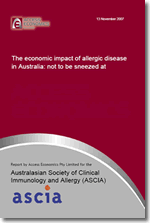Economic Impact of Allergies

The cost of allergies to the Australian economy is more than $7 billion per year, and most Australians face a wait many months to see a specialist, if they can access care at all. These are among key findings in a report by Access Economics to be released by the Australasian Society for Clinical Immunology and Allergy (ASCIA).
The report, 'Economic Impact of Allergies' outlines how the financial cost of allergies in 2007 was $7.8 billion, with lost productivity and health system expenditure the major contributing factors.
 Economic Impact of Allergies November 2007 1.65 Mb
Economic Impact of Allergies November 2007 1.65 Mb
The estimated cost to Australians who suffer from allergy due to reduced quality of life (the "burden of disease") is estimated at $21.5 billion, approximately double the estimated figures for arthritis ($11.7 billion) and hearing loss ($11.7 billion).
Not only does Australia have one of the highest prevalences of allergic disorders in the developed world, but recent studies have demonstrated a doubling in some conditions such as allergic rhinitis (hay fever), eczema but more recently, potentially dangerous anaphylaxis (mainly due to food) as well. Asthma, hay fever, chronic sinusitis and "other allergy" comprise 4 of the top 10 most common long-term self-reported illnesses in youth aged 12-24 years in Australia.
Allergic disorders mostly affect children and young adults and have a negative impact on quality of life. In children these disorders affect sleep, impair learning, memory and behaviour. Children with food allergies are also at significant risk, and the condition means extra stress for their families over issues such as care at school, risk of death and the need for emergency medication in the form of injectable adrenaline.
In adults, allergic disorders lead to impaired quality of life, increased absenteeism from work, reduced productivity when they are at work ("presenteeism") and are a significant financial burden.
Explanatory Notes On Access Report
Epidemiology
- 4.1 million Australians (19.6%) have at least one allergy
- The highest prevalence is in the working population, with 78% of those with allergy aged 15-64 years
- The average allergic person has 1.74 allergies. i.e. most people suffer from more than one condition at the same time. Eg. hay fever and asthma, or food allergy and eczema
- If current time trends continue, there will be a 70% increase in the number of Australians with allergies affected from 4.1 million now to 7.7 million by 2050, and an increased proportion affected from 19.6% to 26.1%
Financial Burden
- In 2007 the calculated cost of allergies is $7.8 billion.
- This is due to lower productivity ("presenteeism" $4.2 billion), direct medical costs ($1.2 billion) lower employment rates ($1.1 billion), absenteeism and lost household productivity ($0.2 billion) and premature death ($83 million).
- Individuals with allergies and their families bear 49% of the financial costs of allergic disease.
- Patients with allergies spend over $120 million/year on across the counter allergy medications
- If the cost of wellbeing is included, then allergic patients bear 86% of the costs.
Report released: November 13, 2007
Content updated January 2010
